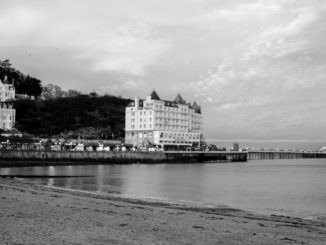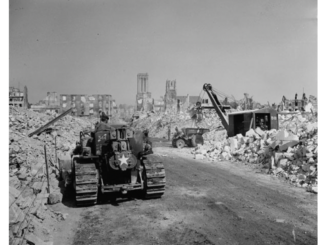In May 1969 my uncle, John Alldridge, described the voyage of Allcock and Brown for the Montreal Star. This is the last of his reports. – Jerry F

John Alldridge recalls the epic flight of Alcock and Brown,
Montreal Star – Newspapers.com, reproduced with permission
It was 4.28 GMT when the heavily loaded Vimy crossed the Newfoundland coastline and headed east across almost 2,000 miles of open sea.
Ahead of them lay a great bank of fog, cutting off the horizon like a monstrous cloud.
Within a few minutes they were in the thick of it; and for half an hour they flew blind, relying on dead reckoning for their navigation.
Time passed. Then growing increasingly anxious, Brown decided to send a message back to Newfoundland. He tapped away at the Morse keys balanced on his knee. But his transmitter was dead. He stood up in the cockpit, screwing his eyes against the wind and saw the cause of the trouble. The propellor shaft of the wireless generator, fixed on one of the wing struts, had blown away.
Now they were completely cut off in a whirl of drifting fog. Worse still the generator had also supplied the current for their electrically-heated flying suits. From now on the cold would be intense.
On and on they flew, engulfed always in the swirling fog. They had been flying blind for almost two hours before Alcock, nursing his engines carefully, could lift the huge plane above the fog-bank into a patch of comparatively clear sky. Now they had a ceiling of cloud above them and below them a carpet of fog …
It was close on 6 p.m. and they reckoned they were 2,000 ft. above the Atlantic when a sudden raucous bark from the starboard engine startled them into looking round: to see flames streaming from the engine.
A section of exhaust pipe had come away close to the manifold.
Miraculously the flames were not touching the Vimy’s fragile body. But from then on they were deafened by the unmuffled roar of the engine and could only communicate by written notes.
And always that blinding fog, stinging their eyes, half choking them.
By now, squeezed into that tiny cockpit, Brown particularly, with his game leg, was suffering severely from cramp.
Then shortly after midnight they flew out of the cloud and fog at last and into a clear night sky full of stars; with the light of a full moon throwing a giant shadow of the Vimy on the clouds below. It was the moment Brown had been waiting for.
With fingers so numb that he could barely adjust the screws of his sextant Brown stood up painfully in the cockpit and took the angle-readings of Vega and the Pole Star to work out their position. Jubilantly he found they had already flown 850 miles. They were halfway across! To celebrate they made a picnic supper of sandwiches and coffee, laced with Dr. Campbell’s whisky.
By 1 a.m. on the Sunday morning of June 15 both men were beginning to feel the full physical strain of the flight. They had been in action now for nearly 24 hours. They had lost all feeling in their legs. Brown’s eyes ached from watching the tiny green glow on the instrumental panel.
Alcock, a bigger man than Brown, had never once removed his feet from the rudder bar or both hands from the joy-stick. But the rhythmical throb of their engines was an abiding comfort.
At 3 a.m. they had been airborne for close on 11 hours, Ireland was only 600 miles ahead of them now and they had plenty of petrol in reserve. So far, so good.
And then at 3:10 they found themselves aiming straight at disaster. The moon suddenly vanished and they saw with horror a great black mass of storm cloud towering as high as a mountain range straight ahead.
There was no time to alter course. Straight as an arrow the Vimy flew into the centre of the storm.
Helpless in the grip of its fury, the big plane was thrown across the sky like a shuttlecock. Blinded by the jagged flashes of lightning they knew they were helpless now, for in that maelstrom their instruments were useless.
At 4,000 ft. the Vimy, completely out of control, went into a spin and quickly began to lose height. It plunged down towards the icy Atlantic. Not even Alcock’s skill, as he gradually fought for and regained control, could stop that dive until they were within 50 ft. of the sea and the Vimy was almost on its back.
Somehow Alcock managed to right it, instinctively centralised joy-stick and rudder, and forced the overburdened machine screaming up to 7,000 ft: only to run once more into a blinding blizzard of hail and snow.
Almost at once the surface of the aircraft started to ice up and the two engines began to labour. Through goggles filmed with ice Brown saw that the engines’ air intakes were blocked with snow. Unless they were cleared quickly the choked engines would give up.
He knew there was only one thing to be done. If they were to survive he must go out on those wings … And so Brown, the cripple, released his safety belt, removed his mittens and climbed out on the fuselage. Alcock tried to hold him back. But he shook off his hand and clambered out onto the wing: gripping the wooden struts that braced the port engine.
Slowly, painfully slowly, he chipped with his penknife at the gauge intake until it was free of ice. Then, while a 100 m.p.h. wind tore at him, and the blinding snow settled round him like a shroud, he fought his way across to the gauge on the other wing and cleared that too.
Meanwhile Alcock had to use all his skill to keep the Vimy on a level flight. One false move and Brown would have been swept off into the Atlantic 9,000 ft. below.
Their efforts were rewarded. As Brown regained his seat he heard the engines pick up and resume their normal note. But that was not the end of it. Five more times during that terrible night Brown had to make that nightmare walk out on the frozen wings …
It was 7.20 in the morning when they finally came out of the cloud and saw the sun for the first time in 14 hours. The controls were beginning to ice up again; so Alcock decided to come down to find warmer air. He throttled back the engines and put the plane into a shallow dive. At 500 ft. he levelled out of cloud into clear air.
For 19 minutes they cruised along 200 ft. over the green Atlantic, their tired eyes searching the horizon for a sign of land. To break the monotony Brown brought out the flask of coffee, and had just poured a cup when he felt Alcock gripping his arm. The pilot — quite inaudibly — was yelling with mad delight, a frantic finger pointing dead ahead.
There, dead in line with the nose of the Vimy, were two tiny specks.
Brown checked on his charts. No doubt about it. They were the islands of Inish Edshal and Inish Turbot. And looming faintly behind them, a deep violet haze in the morning air, were the mountains of Connemara. It was 8.15 a.m. …
Ten minutes later they were flying over green fields and a neat little town which Brown identified as Clifden, Co Galway. Close to the town was a wireless station and near it what appeared from that height to be a large meadow of emerald green grass. Alcock fired his red Very lights and headed for it.
Below now he could see people running and waving. Jubilantly he waved back, not knowing that the greeting was in reality a warning. The “meadow” was in fact Derrygimla Bog. Too late the Vimy’s wheels skimmed over pools of oily water; then dug themselves into the mud.
The engines stopped abruptly and as gracefully as a ballet dancer performing an intricate pirouette, the huge bomber stood up on its nose …

At journey’s end, a muddy bog. They crashed,
Montreal Star – Newspapers.com, reproduced with permission
As the rescuers came rushing towards them Alcock and Brown leant back in their safety belts, badly shaken but unhurt.
Brown was the first to move. He looked at his wristwatch and, carefully noted the time. It was exactly 8.40 a.m. Then he unbuckled his safety belt and eased himself out of his seat. “That’s the best way to cross the Atlantic, eh, Jack,” he said with exaggerated nonchalance.
For once Alcock was not smiling as he replied:
“I got more fun out of my first solo!”
They had made it! They had crossed the Atlantic non-stop; 1,880 miles in 15 hours and 57 minutes at an average speed of 118 miles an hour.
Through the courage and unflinching tenacity of two young Manchester men, drawn together by coincidence and a mutual ambition, Transatlantic flying had become a reality.
The nation responded in its admiration and gratitude; bestowing on them the sort of mass hero-worship which today is accorded to space pioneers.
On June 20, 1919, at a luncheon at the Savoy Hotel they were presented with their £10,000 prize money.
Making the presentation Winston Churchill, then Secretary of State for War, announced that King George V had granted immediate knighthood to Sir John Alcock and Sir Arthur Whitten Brown.

John Alcock and Arthur Brown arrive at Windsor,
Montreal Star – Newspapers.com, reproduced with permission
On July 17 the city of Manchester welcomed them home at a glittering civic reception in the town hall. And for some weeks the two fliers were lionised wherever they went. At Windsor, where they had gone to be knighted by the King, the boys of Eton College mobbed them at the station, took the horses out of their carriage and pulled it up the hill.

How the Montreal Star of June 16, 1919 reported the flight,
Montreal Star – Newspapers.com, reproduced with permission
Impatiently they endured their roles as public figures. Both hated the fuss and the speech-making. But by the end of July it was all over. And then the partnership so casually begun was as casually dissolved.
They never met again. Six months later — on December 18 — John Alcock was killed while testing a new flying boat at Rouen. He is buried in Southern Cemetery, his grave marked by a replica in stone of a four-bladed propeller.
Brown never flew again. After Alcock’s death he lost interest in flying and returned to his engineering. Heartbroken by the death of his son in the battle of Arnhem, he died in Swansea in 1948.
The older attendants at the Science Museum recall a man with a limp who used to visit the aeronautics gallery each anniversary of that first Transatlantic flight. They recall how he would stand there, looking up at the Vimy. Looking up and remembering …
Reproduced with permission
© 2022 Newspapers.com
Jerry F 2023



